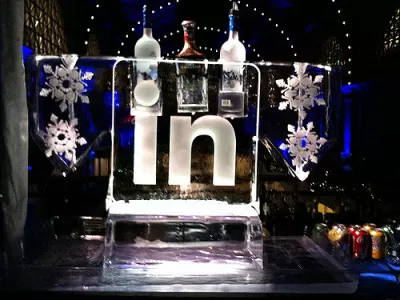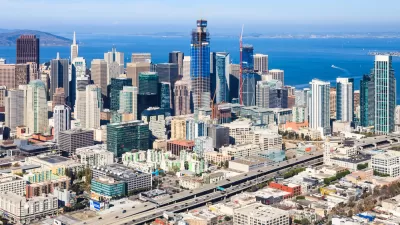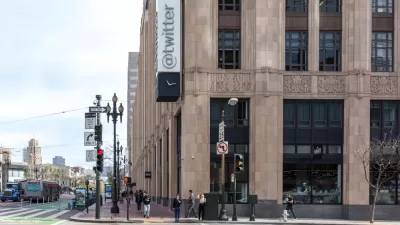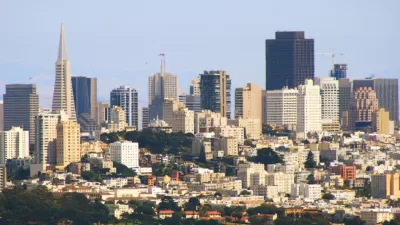Urban design critic John King’s aversion to LinkedIn’s new office space points to long-standing tensions in San Francisco.

Designed by Gensler and Thomas Phifer, the LinkedIn office in San Francisco's South of Market district is either the city's "Black Swan" or a soulless overlord.
To some, the 26-story glass tower and its ground-floor public space convey elegance and grace. The pillar of dark glass reflects light in different ways throughout the day; at the lower level, the smoky tint lifts away to create a transparent entry.
But what Phifer bills as "muted," "soft," and "rich," San Francisco Chronicle critic John King calls "sullen," a "void," and a "black hole"—likening the dark structure to Darth Vader.
Phifer and developer Tishman Speyer are both New York-based, and LinkedIn is one of a few tech giants snapping up San Francisco's space—and, some would argue, its soul.
"The newcomer serves as a cautionary tale showing what can happen when out-of-town developers and architects have their own vision of what a city like San Francisco should be," King writes.
King's complaint isn't with 222's architectural achievement. It's that in his view, the design claims a neighborly attitude while making no attempt to work with its surroundings—an argument not unlike those made against tech companies themselves.
Even in the building's formally public area, King writes, "spectacle trumps civility… Impressive? Yes. Would you relax there with a book, or meet an old friend for a cup of coffee? Maybe not."
It's all part, he says, of a "chic veil" that, when stripped away, reveals "nothing more than a container designed for tenants seeking large floorplates — a real estate pro forma that’s as big as the city would allow it to be."
More on the building at 222's website.
FULL STORY: SF skyline’s new LinkedIn addition is built by, for New Yorkers

Study: Maui’s Plan to Convert Vacation Rentals to Long-Term Housing Could Cause Nearly $1 Billion Economic Loss
The plan would reduce visitor accommodation by 25% resulting in 1,900 jobs lost.

Alabama: Trump Terminates Settlements for Black Communities Harmed By Raw Sewage
Trump deemed the landmark civil rights agreement “illegal DEI and environmental justice policy.”

Why Should We Subsidize Public Transportation?
Many public transit agencies face financial stress due to rising costs, declining fare revenue, and declining subsidies. Transit advocates must provide a strong business case for increasing public transit funding.

Paris Bike Boom Leads to Steep Drop in Air Pollution
The French city’s air quality has improved dramatically in the past 20 years, coinciding with a growth in cycling.

Why Housing Costs More to Build in California Than in Texas
Hard costs like labor and materials combined with ‘soft’ costs such as permitting make building in the San Francisco Bay Area almost three times as costly as in Texas cities.

San Diego County Sees a Rise in Urban Coyotes
San Diego County experiences a rise in urban coyotes, as sightings become prevalent throughout its urban neighbourhoods and surrounding areas.
Urban Design for Planners 1: Software Tools
This six-course series explores essential urban design concepts using open source software and equips planners with the tools they need to participate fully in the urban design process.
Planning for Universal Design
Learn the tools for implementing Universal Design in planning regulations.
Smith Gee Studio
Alamo Area Metropolitan Planning Organization
City of Santa Clarita
Institute for Housing and Urban Development Studies (IHS)
City of Grandview
Harvard GSD Executive Education
Toledo-Lucas County Plan Commissions
Salt Lake City
NYU Wagner Graduate School of Public Service





























